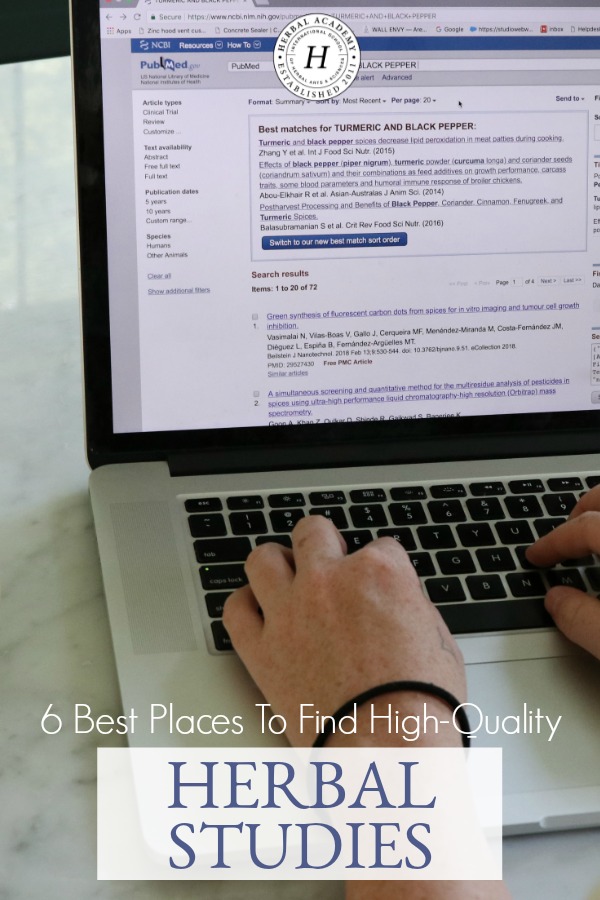
6 Best Places to Find High-Quality Herbal Studies
Staying abreast of herbal research is a worthwhile undertaking for any herbalist, but knowing where to look for high-quality herbal studies can be a challenge. To find relevant research on herbs for your practice, consider the following six places where high-quality herbal studies can be found.
6 Places to Find High-Quality Herbal Studies

1. The Herbarium by Herbal Academy
A good place to start is at Herbal Academy’s membership site, The Herbarium. For a small yearly fee, you get access to a plant monograph database featuring detailed summaries of more than a hundred herbs. Each monograph includes plant identification and harvesting tips, traditional and modern uses, safety information, suggested applications, and other valuable information backed by science.
The Herbarium won’t cover every single herbal study on the planet, but it’s curated for modern herbal practice. The entire database is routinely updated with new monographs, too.
2. Herbal Industry Associations
Herbalists are fortunate to have a number of established herbal associations to turn to for professional support. Herbal associations like the American Botanical Council and the American Herbal Products Association frequently publish science-based guidance for operation practices like proper herbal collection and storage, botanical safety, and compounding and dispensing of herbs.
These groups are also great at gathering high-quality herbal health studies and sharing them with the public. The American Botanical Council publishes a free herbal scientific database called HerbMed, with access to even more plants with a paid subscription, as well as a monthly scientific magazine called HerbalGram. Likewise, the American Herbal Products Association offers its own educational resources for your researching needs.
Again, herbal associations are numerous. With a little browsing, you may find one that addresses your business best while providing scientific research to improve your herbal knowledge and practice. The Alliance of Aromatherapists, for example, promotes on its website a number of aromatherapy-specific science publications.
Whether you work for a large-sized herbal company or you run your own business, you’ll find that the information from these associations is very useful.

3. PubMed
If you’re looking for especially unique information on herbs, or you’re just curious to see a greater scope of what’s out there, visit PubMed. The National Institutes of Health (NIH) -supported website contains literally millions of scientific citations spanning hundreds of journals and health and medicine topics as well as phytotherapy research.
The sheer scope of PubMed can make the site almost too comprehensive, but it does open up opportunities to access a wide variety of high-quality herbal research that you might have a hard time finding elsewhere. Use a keyword search, filter results by categories — complementary medicine, dietary supplement, history of medicine, toxicology, etc. — and your searches get a bit easier. You can even make an RSS feed to notify you when new research on a particular ingredient or plant is published.
Although PubMed houses millions of scientific citations — and many that you may want to read — they’re not always available for free, full-page viewing, or what the scientific publishing community calls “open access.” In some cases, only an abstract is available on PubMed. Alternatively, the full study may be available free or for purchase at the original publisher’s website, so be sure to look for links to original journals on any PubMed study page.
For exclusively free, full-study reading on PubMed, searches can be filtered to only include results from PubMed Central (PMC), PubMed’s open access archive.

4. Independent Publishers
What PubMed doesn’t make available, independent publishers are sure to provide either free or for a price. Big scientific publishing houses like Springer, Elsevier, and Wiley now control a majority of global scientific journals, and you’ll find yourself on one or more of their sites if you’re especially keen on reading full-text herbal studies over summaries published elsewhere.
Access to herbal studies from independent publishing houses is at the publisher’s discretion. Sometimes, open access is granted but only after a period of time has passed. Where full studies aren’t available free of charge, viewing an abstract or even the (sometimes available) first few pages of a study can be beneficial.
If you find that a journal is especially relevant to your practice, consider subscribing or looking into other modes of access such as a local library or university subscriptions. You can find a shortlist of scientific journals below.
5. Open Access
In response to what many consider woefully high prices for journal subscriptions, open access journals have emerged as an alternative method for free distribution of scientific information to the world. In addition to PubMed Central mentioned above, PLOS One, PeerJ, and BMC Central are noteworthy examples of publishers and journals that have achieved completely open access, whether through government subsidies, private grants, and/or other means (Larivière, Haustein, & Mongeon, 2015; Van Noorden, 2013). They’re full of high-quality herbal research, too.

6. Herbal Research Journal Shortlist
Are you looking for scientific journals catered especially to high-quality herbal research? Courtesy of the American Herbal Products Association, here’s a short list of herb-centric scientific journals to get you started.
- American Journal of Botany
- Economic Botany
- Fitoterapia
- HerbalGram
- The Journal of Alternative & Complementary Medicine
- The Journal of AOAC International
- Journal of Ethnopharmacology
- Journal of Natural Products
- Pharmaceutical Biology
- Phytochemical Analysis
- Phytochemistry
- Phytomedicine
- Phytotherapy Research
- Planta Medica
Now that you know some of the best places where herbal studies are collected, it’s time to start learning more about the herbs and ingredients that matter to your practice and finding herbs to support the uses of those herbs.
Stay tuned for future blog posts here on the Herbal Academy blog about how to better understand herbal studies and to determine their strength and integrity.

REFERENCES:
Larivière, V., Haustein S., & Mongeon P. (2015). The oligopoly of academic publishers in the digital era. PLoS One, 10(6). doi: 10.1371/journal.pone.0127502
Van Noorden, R. (2013). The true cost of science publishing. Nature, 495(7442), 426-429. doi: 10.1038/495426a








